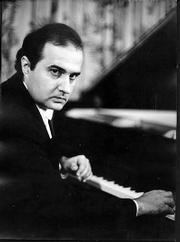12.14.7 Jorge Luis Prats Soca

Jorge Luis Prats Soca, a Cuban concert pianist and teacher of international acclaim. He was born in 1956 in Central Violeta, Camagüey province. He began his studies in music theory, music theory, and piano at the Fernández Vilá Conservatory in Havana with Bárbara Díaz Alea, a student of César Pérez Sentenat.
In 1971, he entered the National School of Art (ENA), where he studied with Margot Rojas and later with Frank Fernández, acquiring a solid technical foundation and a broad concept of art.
Prats received lessons in Paris from the Brazilian pianist Magda Tagliaferro, who introduced him to the works of Héctor Villa-Lobos and Arthur Rubinstein. At the Vienna Conservatory of Music, he studied with Paul Badura-Skoda, a specialist in the interpretation of works by Wolfgang Amadeus Mozart, Ludwig van Beethoven, and Frank Schubert. He also worked with Rudolf Kerer at the Moscow Conservatory, studying in detail the works of Alexander Scriabin, Sergei Prokofiev, Sergei Rachmaninov, and Pyotr Ilyich Tchaikovsky. This professor also taught him to analyze the structure of the works he performed and to familiarize himself with these composers.
He has won several awards, including the Amadeo Roldán Competition for Intermediate Level Piano Students, First Prize (1975). At the 17th Marguerite Long-Jacques Thibaud International Competition in Paris, he was awarded the Grand Prix by a unanimous jury vote, in addition to the Chevillon-Bonnaud Prize for Best Performer. He won the prize for Best Performance of French Music with “Scarbó” from Gaspar de la Nuit, a piece that faces all kinds of technical difficulties and must be played very well to convince an audience, requiring a very subtle and ethereal interpretation. The results of the Competition were announced at the Théâtre des Champs-Élysées on July 16, 1977. During the Competition, Prats performed Concerto No. 1 for piano and orchestra, Etude No. 7, Op. 10, and Fantasia in F minor by the Polish composer Frédéric Chopin; Concerto No. 1, for piano and orchestra, and Etudes, by the Hungarian composer Franz Liszt; Cinq dances rituelles, the compulsory piece for the Competition, by André Jolivet. Jolivet’s widow, who was a jury advisor, expressed that when she heard Prats, she thought she was hearing the composer’s own interpretation, and so she told the jury members that, in her opinion, the winner had already been determined.
Jorge Luis Prats has performed with the Tours Symphony Orchestra, the Pays de la Loire Orchestra, and the Pasdeloup Concert Association in Paris. In 1991, he appeared at the Guildford Guildhall; a critic for the Surrey Advertiser stated that this performance of unusual artistic stature surprised the musicians attending the Guildford Guildhall lunchtime recitals, for Cuban pianist Jorge Luis Prats is a surprising artist, a performer of beautiful serenity, neither superficial nor theatrical, whose superb technique complements his skill in musical interpretation.
She has performed under the baton of James Lockhart, conductor of the Rhineland Philharmonic, West Germany; the London Philharmonic Orchestra, where she appeared at the Royal Festival Hall; Enrique Bátiz, conductor of the Mexico City Philharmonic Orchestra; Manuel Duchesne Cuzán, conductor of the Cuban National Symphony Orchestra; Tomás Fortín, guest conductor of the National and Santiago de Cuba Symphony Orchestras; and Guido López-Gavilán, conductor of the Cuban National Symphony Orchestra.
This renowned Cuban pianist appears alongside Paul Badura-Skoda and Jorg Demus in the film *The Story of the Piano*, playing Franz Liszt’s Hungarian Rhapsody No. 2 on a vintage piano. He also performed *Las delicias de Rosita* and *Los muñecos* by Cuban composer Ignacio Cervantes, and accompanied Uruguayan singer Graciela Nasser, first soloist at the Teatro Colón in Buenos Aires, Argentina, and at the Metropolitan Opera House in New York, United States, who performed Nhapopé by Brazilian composer Héctor Villa-Lobos.
Prats’ repertoire is very broad, encompassing works by numerous composers such as Bach, Rachmaninov, Liszt, Tchaikovsky, Scriabin, Prokofiev, Mozart, Schubert and Beethoven, as well as the Argentine Alberto Ginastera, the Brazilian Héctor Villa Lobos and the Cubans Ignacio Cervantes, Manuel Saumell, Ernesto Lecuona, Alfredo Diez Nieto, Carlos Fariñas and Juan Piñera.
He received a review in the Journal de Geneve, reflecting the supreme artistry he displayed at an evening performance at the United Nations headquarters in Geneva: “Behind every challenge, the artist grows. With every composer, the artist is the soul of Ravel, Granados, Schumann, and Liszt. In the coherence of his style, one senses the presence of a genius. He moves back and forth from power and tension to pause and silence, and he conveys violence and pain. Everything he touches is music.”
Prats has taught classes as a pedagogue at the Instituto Sperior de Arte (ISA) (Calle 120 No. 1110 e/ 9na y 13. Cubanacán. Playa. Havana) and at the University of Santander, Colombia.
He has toured countries such as Colombia, Bolivia, Uruguay, Nicaragua, Guatemala, Mexico, Canada, France, England, Ireland, Holland, Spain, the Federal Republic of Germany, Austria, the former Soviet Union, Poland, Japan, among others.
Jorge Luis Prats possesses a natural flair for playing the instrument and excellent pianistic skills. He evokes the instrument as something very close, very intimate.








